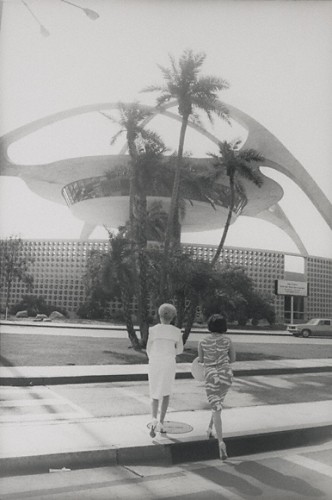News

The most recent issue of Newsweek includes a piece I wrote about the city of Los Angeles. Here’s how it starts:
I came to Los Angeles with a suitcase full of books and shoulder pads stuffed with cash. It was 1992, just a few months after the infamous riots, and I was about to start graduate school at the University of Southern California, near the epicenter of the unrest. One of my professors advised me against coming here—I don’t remember exactly what he said, but the substance of his message could be summarized in three words: Drugs! Guns! Violence! I had been warned so often about muggings that I decided to sew some bills inside the shoulder pads of my jacket. I didn’t know a single soul here.
You can read the rest of the piece on the website of Newsweek.
(Photo credit: Garry Winogrand, Los Angeles International Airport, 1964)
On April 16, the Pulitzer Prize Board announced that there were three finalists for the award in fiction, but no winner—a decision that sparked an outcry in some parts of the literary community. The three finalists were The Pale King, by David Foster Wallace; Swamplandia! by Karen Russell; and Train Dreams, by Denis Johnson. Each book had many vocal supporters, who were understandably upset at seeing their favorite be passed over—and not for another book, but for no book at all.
So the New York Times Magazine asked eight critics and writers, including me, to write about the books they would have chosen for the prize. You can read about our choices here. And you can chime in with your own here.
I want your vote! And the best part is this: I won’t make you, the voter, any promises I can’t keep. Actually, I won’t make you any promises at all. The editors of World Literature Today have chosen my essay “So to Speak” as one of their five favorites of the past decade. Here is how it begins:
Not long ago, while cleaning out my bedroom closet, I came across a box of old family photographs. I had tied the black-and-white snapshots, dog-eared color photos, and scratched Polaroids in small bundles before moving from Morocco to the United States. There I was at age five, standing with my friend Nabil outside Sainte Marguerite-Marie primary school in Rabat; at age nine, holding on to my father’s hand and squinting at the sun while on vacation in the hill station of Imouzzer; at age eleven, leaning with my mother against the limestone lion sculpture in Ifrane, in the Middle Atlas. But the picture I pulled out from the bundles and displayed in a frame on my desk was the one in which I was six years old and sat in our living room with my head buried in Tintin and the Temple of the Sun.
You can read the essay in full here and, if you like it, you can vote for it here.
(Photo credit: Getty Images)
The Los Angeles Times Festival of Books is this weekend. It’s one of my favorite weekends of the year—there’s something for every kind of reader, plus lots of great food and music. I’ll also be doing a panel on Sunday; here are the details:
3:30 pm
Fiction: Conflicting Identities
Panel with Dana Johnson, Laila Lalami, Nina Revoyr, and Antoine Wilson
Los Angeles Times Festival of Books
Annenberg Auditorium
University of Southern California
Los Angeles, California
So come on by and say hello. And don’t forget to wear sunscreen.
My review of Katherine Boo’s amazing book, Behind the Beautiful Forevers: Life, Death, and Hope in a Mumbai Undercity, appears in the latest issue of The Nation. Here is an excerpt:
During the year I spent in Casablanca, I noticed that slums were discussed in the press almost exclusively with the vocabulary of pathology. The karian were “dangerous.” They were places that “tainted” the city and had to be “eradicated.” One journalist called them “a gangrene”; another urged a “hunt for the slums.” The language became even more antagonistic after a failed terrorist attack in March 2007, when it was revealed that one of the suicide bombers, like those who had attacked the city four years earlier, had come from the slum of Sidi Moumen. I remember vividly a television reporter shoving a microphone in a woman’s face in Sidi Moumen and demanding to know why “your” youths did what they did.
I tell you all this because I want to explain why Katherine Boo’s first book, Behind the Beautiful Forevers, struck me with the force of a revelation. Unlike other reporters, who come to the slums in brief and harried visits, only when they have news to report or statistics to illustrate, Boo, a staff writer at The New Yorker, has chosen to chronicle the lives of slum-dwellers in the Indian city of Mumbai by spending more than three years with them, patiently listening to them talk about their aspirations, their struggles and their dilemmas.
Here is one dilemma, all the more disturbing for its banality. Fatima Sheikh, a crippled woman, lies on a bed in Burn Ward Number 10 at Cooper Hospital in Mumbai, an IV bag and a used syringe sticking to her skin. Abdul Hakim Husain, the teenager who is accused of pouring kerosene over Fatima’s body and setting it alight, is in the custody of officers from the Sahar Police Station. After assessing the situation, Asha Waghekar, a part-time schoolteacher and full-time fixer, makes what she deems a very fair offer: Abdul Hakim’s parents can pay her 1,000 rupees and she will persuade Fatima to drop the charges.
You can read the full review here, and you can subscribe to The Nation here.
